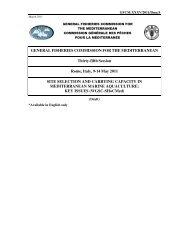English
English
English
Create successful ePaper yourself
Turn your PDF publications into a flip-book with our unique Google optimized e-Paper software.
- Isurus paucus<br />
The species is rare in the area. It is accidentally caught.<br />
14<br />
GFCM:SAC13/2011/Dma2<br />
- Squatina aculeata and S. Squatina<br />
These two species occurred along all Mediterranean coasts. However we think these<br />
squatinidae are disappearing from several areas<br />
- Squalus acanthias<br />
The species occurs along the occidental basin coasts and only along the north coast of oriental<br />
basin of the Mediterranean Sea. The species is abundant in Black Sea (Avsar, D. 2001;<br />
Ademürhan & Seyhan, 2006).<br />
- Centroscymnus coelolepis<br />
The occurrence of this species may be restricted to the north occidental basin. According our<br />
investigations and also in the literature: no mention of this species along the North African<br />
coasts.<br />
- Alopias superciliosus<br />
The species may occupy all the Mediterranean Sea. It was observed in Syria (Saad et al.,<br />
2004), the Ionian Sea and Levantine basin (Megalofonou et al., 2005; Golani, 2005).<br />
- Rhinobatos cemiculus / R. rhinobatos<br />
These two species are common off the south coasts of the Med but no observed along the<br />
north ones (no recorded in MEDITS campaigns) (Bertrand et al., 2000; Baino et al., 2001).<br />
-Dasyatis marmorata<br />
Capapé (1989) suggested that in southern Tunisian waters, D. marmorata undergoes<br />
competitive pressure from related dasyatid species. Consequently, it inhabits restricted areas<br />
in the Gulf of Gabès, entering a closed hyperhaline lagoon, the Bahiret el Biban (Capapé &<br />
Zaouali, 1992, 1993, 1995). Nowadays, this species extends it distribution area (Enajjar,<br />
2009; El Kamel et al., 2009; Golani and Capapé, 2004)<br />
II-3 Critical habitats<br />
Critical habitats should be identified for conservation porpoises. In fact, a big lack of<br />
knowledge on critical habitats of this group was noted in the Mediterranean and Black Sea.<br />
However, some mapping of nursery areas and spawning ground for some species being<br />
carried out by some countries.<br />
Some areas are considered critical habitat for chondrichthyans. For example, Tunisian waters<br />
provide a nursery area for white shark Carcharodon carcharias. Aggregations of basking<br />
shark Cetorhinus maximus, have been observed in the northern Balearic region, the Northern<br />
Adriatic and the Tyrrhenian Sea (Walker et al. 2005). Tunisian waters provide a nursery areas<br />
for great white shark Carcharodon carcharias (Centre of Tunisia) and for the sandbar shark<br />
Carcharhinus plumbeus (Bradai et al., 2005) (gulf of Gabes - south of Tunisia). This area
















